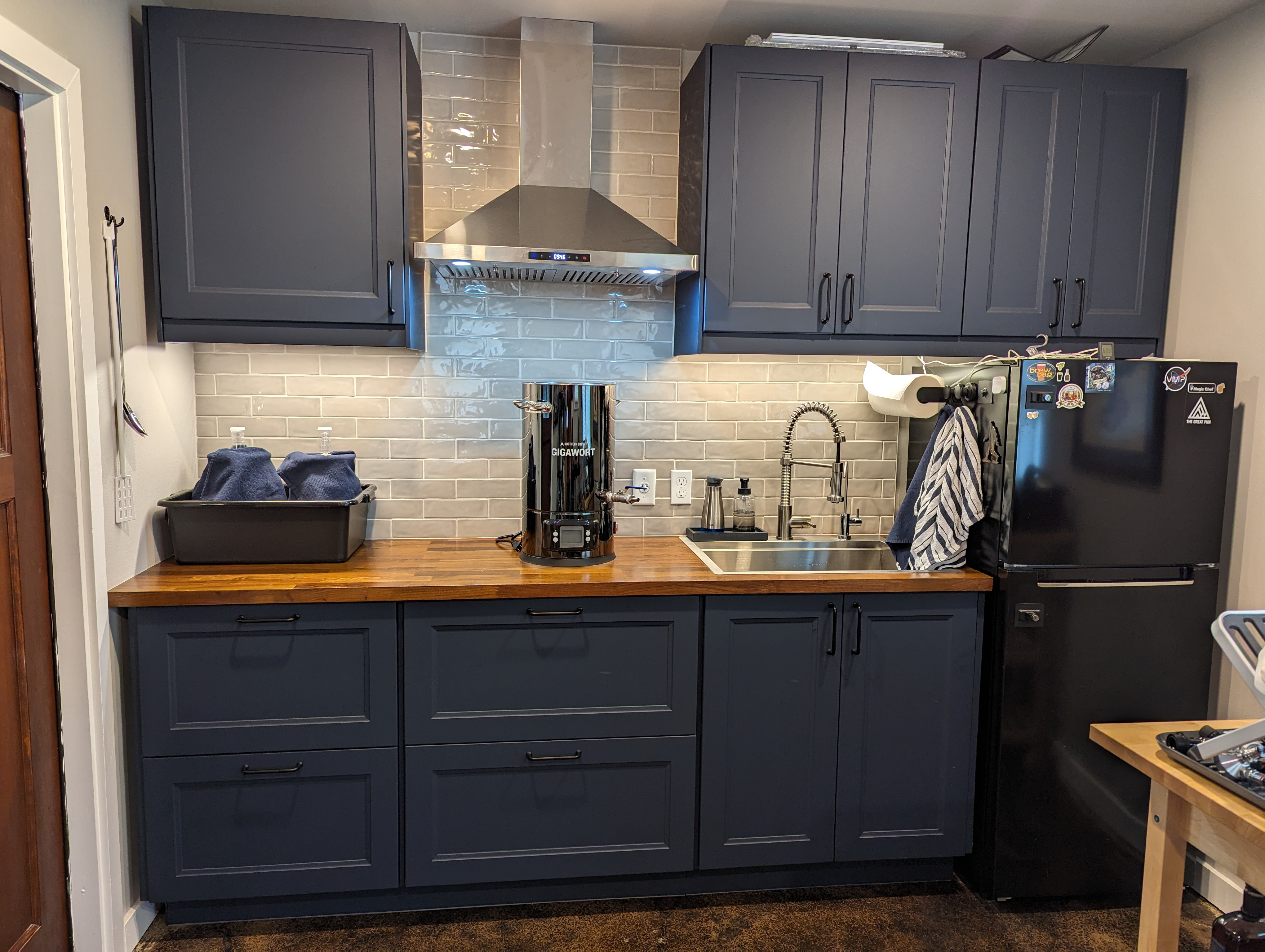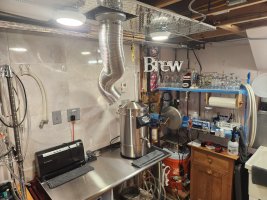For context to what follows, I have a dedicated brewing space that's about 150 sq ft. It's insulated, has a mini-split for heating/cooling, I keep the temp at 68F, and I run a small dehumidifier that keeps the relative humidity in the mid-50% range on average.
Thus far in this new-ish space I've been doing 1-gallon batches and don't see myself moving up to more than 2-gallon batches other than in rare cases where I know I'll need more (brew club potlucks, parties, etc.).
Since I knew I was going to be doing mostly small batches I built things out more or less as you would a small kitchen and installed a typical kitchen range hood (a Cosmo 63175S to be exact).
The issue I'm running into is during the boil I'm getting quite a lot of condensation on the range hood, to the point where I have to keep wiping it off every few minutes to keep it from building up and dropping back into the kettle (and also occasionally causes the control panel on the hood to freak out). I run the range hood with a window at least partially open to make sure I have some makeup air and overall good airflow.
Photo for context (excuse the mess of wires on top of the fridge; cable management is on my list!):

The distance between the countertop of the bottom of the hood is 32", which puts the distance between the top of the Gigawort and the bottom of the hood at about 12".
Here's another photo with a 2-gallon pot on a small induction burner for additional context -- the distance between the top of that pot and the bottom of the hood is about 20", and I have the same condensation issue when I use this setup.

I've verified insofar as I can that the range hood is installed and vented correctly, meaning I can see steam getting pulled into the range hood, I don't get moisture in the rest of the room at all, and when I check the vent on the roof I can feel air flowing out. Also this is a one-story building so the distance between the ceiling of the room and the vent isn't far at all.
So my main question is, have other indoor brewers run into this, and if so how did you address it?
I can't imagine this is just the way it is and I have to deal with it, so at this point the options I'm thinking through are:
As a point of comparison, my wife sometimes has things boiling for longer than an our in our kitchen in the house and there are no condensation issues in there, so I'm hoping this is a solvable problem. (Not a totally apples-to-apples comparison given the range hood in the house is nicer, it's rear-vented as opposed to top-vented, and the distance between the top of the pot and the bottom of the hood is much greater, but still.)
I appreciate any experience anyone has with this issue and any thoughts or suggestions people have.
Thanks!
Thus far in this new-ish space I've been doing 1-gallon batches and don't see myself moving up to more than 2-gallon batches other than in rare cases where I know I'll need more (brew club potlucks, parties, etc.).
Since I knew I was going to be doing mostly small batches I built things out more or less as you would a small kitchen and installed a typical kitchen range hood (a Cosmo 63175S to be exact).
The issue I'm running into is during the boil I'm getting quite a lot of condensation on the range hood, to the point where I have to keep wiping it off every few minutes to keep it from building up and dropping back into the kettle (and also occasionally causes the control panel on the hood to freak out). I run the range hood with a window at least partially open to make sure I have some makeup air and overall good airflow.
Photo for context (excuse the mess of wires on top of the fridge; cable management is on my list!):

The distance between the countertop of the bottom of the hood is 32", which puts the distance between the top of the Gigawort and the bottom of the hood at about 12".
Here's another photo with a 2-gallon pot on a small induction burner for additional context -- the distance between the top of that pot and the bottom of the hood is about 20", and I have the same condensation issue when I use this setup.

I've verified insofar as I can that the range hood is installed and vented correctly, meaning I can see steam getting pulled into the range hood, I don't get moisture in the rest of the room at all, and when I check the vent on the roof I can feel air flowing out. Also this is a one-story building so the distance between the ceiling of the room and the vent isn't far at all.
So my main question is, have other indoor brewers run into this, and if so how did you address it?
I can't imagine this is just the way it is and I have to deal with it, so at this point the options I'm thinking through are:
- Despite my basic checking, the range hood isn't installed correctly or otherwise isn't working properly -- get it checked out by an appliance repair person/installer (we DIYd this install with help from our electrician).
- Insulate the ducting so there's less condensation happening up in the range hood and ducting given the temperature differential.
- The range hood is too low given the height of the kettles -- re-install range hood higher.
- This particular range hood sucks -- get a better range hood.
- Range hoods suck in general for dealing with this much steam -- get a condensation hood (if they even make one for a 30" space).
- Some combo of the above.
As a point of comparison, my wife sometimes has things boiling for longer than an our in our kitchen in the house and there are no condensation issues in there, so I'm hoping this is a solvable problem. (Not a totally apples-to-apples comparison given the range hood in the house is nicer, it's rear-vented as opposed to top-vented, and the distance between the top of the pot and the bottom of the hood is much greater, but still.)
I appreciate any experience anyone has with this issue and any thoughts or suggestions people have.
Thanks!







